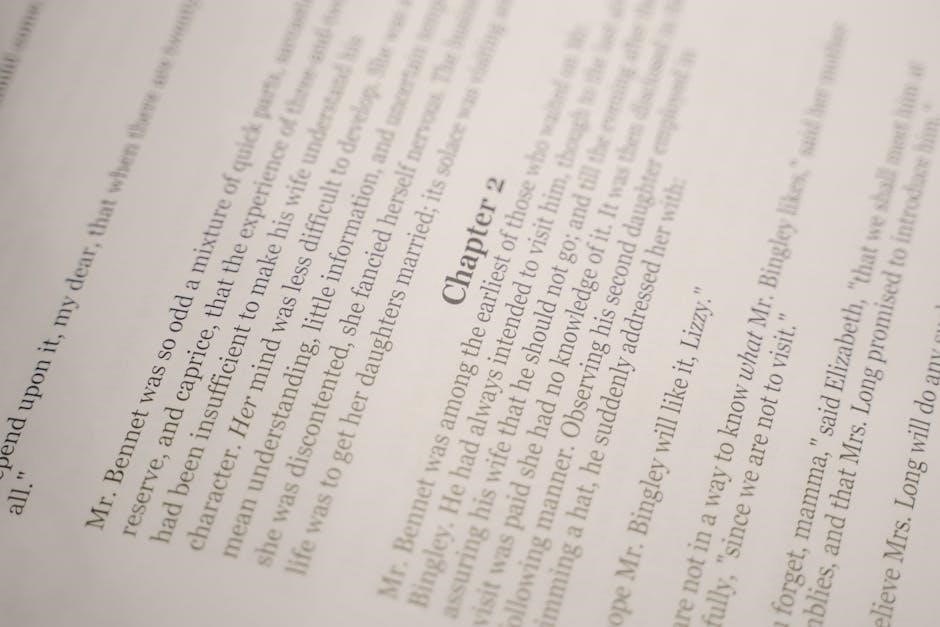
Chapter 2 of Lord of the Flies explores the boys’ struggle to establish order, highlighting their transition from excitement to fear and power struggles. The conch shell emerges as a symbol of democracy, while the “beast” ignites superstition and chaos, setting the stage for the novel’s themes of civilization vs. savagery and leadership conflicts.
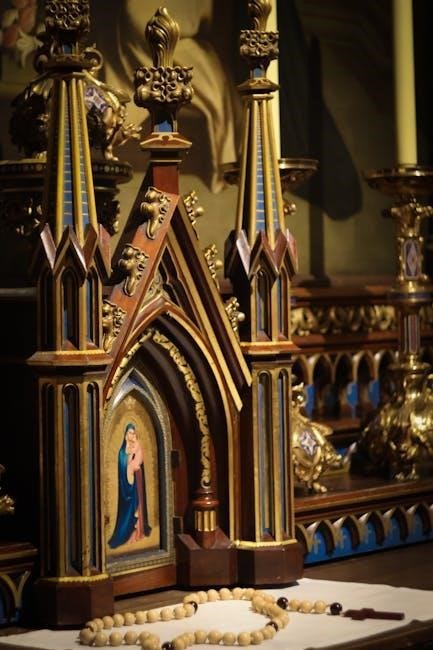
Overview of Chapter 2
Chapter 2 of Lord of the Flies delves into the boys’ attempt to create a structured society on the island. Ralph, as the leader, organizes an assembly where the conch shell is established as a tool for maintaining order and ensuring only one person speaks at a time. The boys discuss their fears, particularly the “beast,” which sparks widespread anxiety. Jack’s enthusiasm for hunting and his desire for power begin to clash with Ralph’s focus on building shelters and maintaining a signal fire. The chapter highlights the early signs of conflict and the struggle to balance individual desires with the collective good. The conch shell becomes a symbol of democracy, but fears and power struggles threaten the fragile order, foreshadowing the chaos to come.
Significance of Chapter 2 in the Context of the Novel
Chapter 2 is pivotal as it lays the foundation for the novel’s central themes and conflicts. The establishment of rules, such as the conch shell for speaking, reflects the boys’ initial attempt at civilization. However, the fear of the “beast” and the emergence of power struggles between Ralph and Jack signal the gradual descent into chaos. This chapter introduces the tension between order and savagery, highlighting Golding’s exploration of human nature. The conch shell symbolizes democracy and civility, while the beast represents primal fears, setting the stage for the novel’s examination of how isolation and fear can erode societal norms. By the end of Chapter 2, the seeds of conflict and the boys’ inner savagery are sown, making it a critical chapter for understanding the novel’s progression.
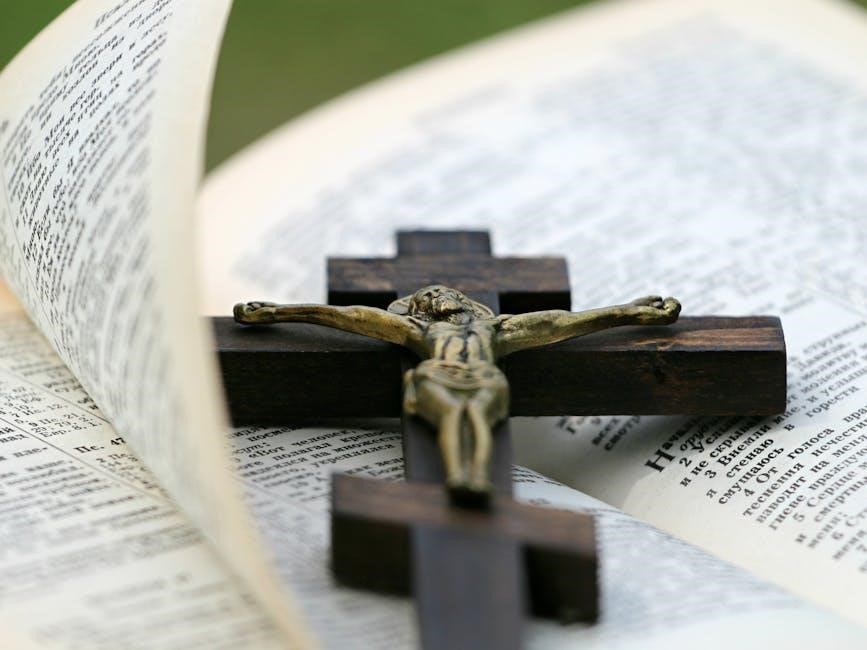
Key Themes in Chapter 2
The chapter explores civilization vs. savagery, leadership struggles, and fear. The conch shell symbolizes order, while the beast embodies primal fears, highlighting the boys’ fragile grip on civility.
Civilization vs. Savagery
In Chapter 2, the theme of civilization vs. savagery emerges as the boys attempt to create order but are drawn to primal instincts. The conch shell, a symbol of democracy and civility, is used to maintain order during meetings. However, the fear of the “beast” and the boys’ increasing paranoia reveal their inner savagery. Ralph’s emphasis on building shelters and maintaining the signal fire represents his commitment to civilization, while Jack’s desire for hunting and power reflects a shift toward savagery. The chapter shows how quickly the boys’ behavior deteriorates when fear and superstition take hold, highlighting the fragile nature of civilization. This tension between order and chaos sets the stage for the novel’s exploration of human nature, as the boys struggle to balance their civilized instincts with primal urges.
Leadership and Power Struggles
In Chapter 2, leadership and power struggles become central as the boys attempt to organize themselves on the island. Ralph, elected as the leader, tries to establish rules and a sense of order, emphasizing the importance of the conch shell for democratic decision-making. However, Jack’s growing ambition and desire for control create tension, as he challenges Ralph’s authority. The chapter highlights the conflict between Ralph’s focus on survival and civility and Jack’s emphasis on hunting and power. Piggy, as the voice of reason, supports Ralph’s leadership but struggles to assert his influence. The power dynamics between the characters reveal deeper themes of governance, authority, and the natural human inclination toward leadership hierarchies. This struggle sets the stage for the eventual breakdown of their democratic system and the rise of a more primal form of leadership.

Fear and Superstition
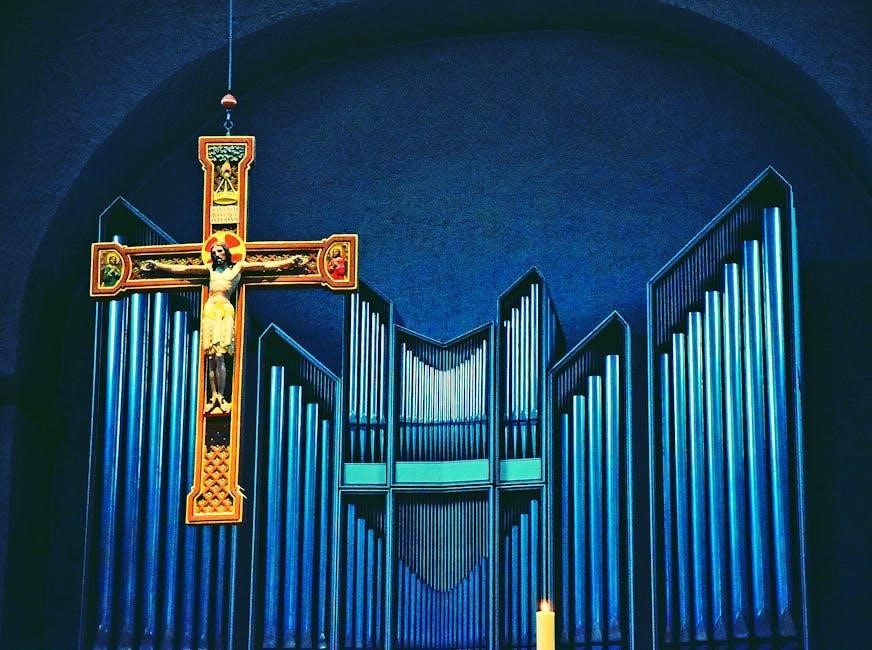
In Chapter 2, fear and superstition begin to emerge among the boys, driven by the younger ones’ tales of a “snake-like beast” on the island. This fear escalates tensions and undermines the group’s fragile sense of order. Ralph dismisses the idea of the beast, but the littluns’ persistent terror creates an atmosphere of dread. Jack’s aggressive response to the fear—offering to hunt the beast—exacerbates the situation, revealing his primal instincts. The conch, once a symbol of civility, loses its power as fear and chaos take hold. Golding uses this chapter to explore how fear can destabilize even the most organized systems, highlighting the boys’ vulnerability to irrational beliefs. The fear of the beast becomes a recurring theme, symbolizing the deeper, unspoken terrors within human nature that threaten their attempts at civilization.
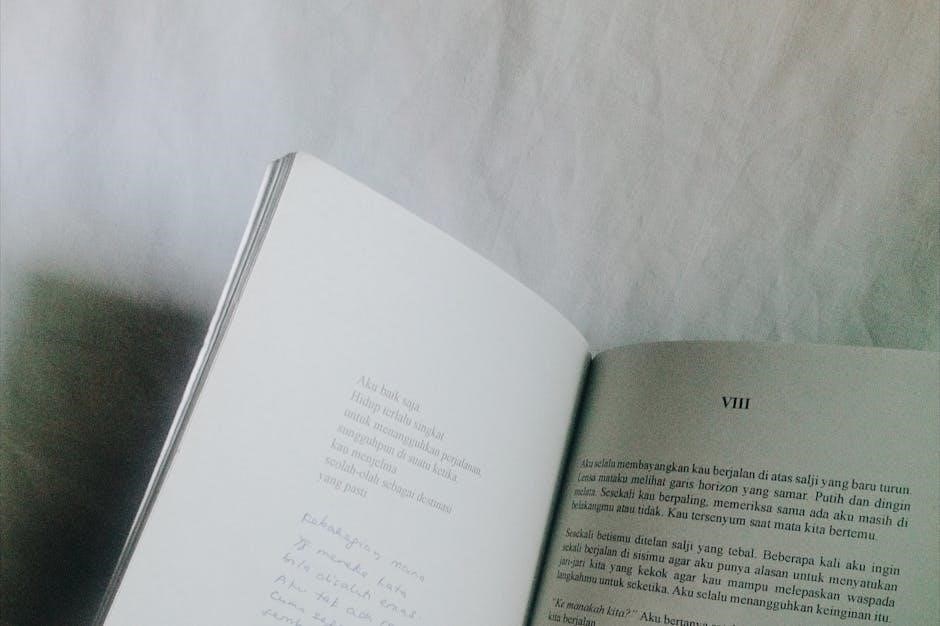
Character Development in Chapter 2
Ralph’s leadership is tested as he tries to maintain order, while Jack’s desire for power grows. Piggy’s rationality contrasts with the littluns’ escalating fears, revealing vulnerabilities and shifting dynamics.
Ralph’s Leadership Qualities
Ralph demonstrates strong leadership qualities in Chapter 2, emphasizing fairness and organization. He establishes rules, such as requiring the conch shell for speaking, to maintain order. Ralph’s idea to build shelters and manage tasks showcases his responsibility and focus on survival. However, his leadership is challenged by Jack’s growing ambition. Ralph’s commitment to democracy and the conch symbolizes his belief in civility. Despite facing opposition, Ralph remains determined to lead effectively, highlighting his maturity and sense of duty. His actions reflect a balance between authority and compassion, making him a natural leader. Ralph’s decisions, though sometimes questioned, aim to benefit the group, revealing his selflessness and understanding of their situation. His leadership qualities are central to the chapter’s themes of order and governance.
Jack’s Ambition and Aggression
In Chapter 2, Jack Merridew’s ambition and aggression become prominent as he challenges Ralph’s leadership. Jack believes he should lead due to his confidence and hunting skills, showing his desire for power. His frustration grows when Ralph prioritizes building shelters over hunting, leading to tension. Jack’s aggressive behavior is evident when he argues with Ralph and dismisses the littluns’ fears, focusing instead on proving his dominance. His obsession with hunting symbolizes his primal instincts and desire to assert control. Jack’s actions reveal his impulsive nature and willingness to disregard rules for personal gain. This ambition creates conflict and highlights Jack’s potential to embrace savagery. His rivalry with Ralph escalates, setting the stage for future power struggles and the island’s descent into chaos. Jack’s aggression foreshadows his eventual transformation into a more savage leader.
Piggy’s Role as the Voice of Reason
Piggy emerges as the voice of reason in Chapter 2, offering intellectual insights and practical solutions. He suggests using the conch shell to maintain order during meetings, emphasizing its importance as a symbol of democracy. Piggy’s logical thinking is evident when he proposes keeping the fire lit to signal for rescue, showcasing his focus on survival and rescue. Despite his physical limitations, Piggy’s ideas are crucial, such as his suggestion to build shelters and track time. However, his contributions are often dismissed by the other boys, who underestimate his intelligence due to his appearance and asthma. Piggy’s attempts to enforce rules and prioritize safety highlight his commitment to civilization. His role underscores the theme of wisdom being overlooked in favor of physical strength and charisma, foreshadowing the tragic consequences of ignoring reason. Piggy’s voice of reason becomes a moral anchor amid the island’s growing chaos.
The Littluns and Their Fears
The Littluns, the youngest boys on the island, play a significant role in Chapter 2 as their fears and vulnerabilities surface. Their terror of the “beastie” or “snake-like creature” becomes a central concern, spreading panic among the group. The little boy with the birthmark is particularly traumatized, describing the creature as a “snake-like” figure that terrifies him. This fear resonates with the other boys, creating a sense of dread and superstition. The Littluns’ inability to articulate their fears clearly exacerbates the chaos, as their stories are often fragmented and exaggerated; Their vulnerability highlights the group’s fragile state of civilization and the growing influence of irrational fears. The older boys’ reactions to the Littluns’ fears, particularly Jack’s dismissive attitude, reveal emerging power dynamics and the erosion of empathy. The Littluns’ fears thus serve as a catalyst for the novel’s exploration of human nature and the breakdown of order.

Symbolism in Chapter 2
The conch shell symbolizes order and democracy, as it grants speaking rights, while the “beast” represents primal fears and the unknown, reflecting the boys’ descending savagery and rising superstition.
The Conch Shell as a Symbol of Order
The conch shell emerges in Chapter 2 as a powerful symbol of democracy and civility. Ralph discovers its significance and uses it to establish rules, ensuring only the holder can speak during assemblies. This creates a sense of order and fairness, allowing even the quietest voices, like Piggy’s, to be heard. The conch represents the boys’ attempt to mimic societal structures, maintaining decorum and preventing chaos. However, as the chapter progresses, the shell’s authority begins to waver, reflecting the boys’ gradual slide into savagery. Its shine and size emphasize its importance, but its eventual decline mirrors the erosion of their civilized behavior. The conch shell thus serves as a fragile symbol of their fleeting commitment to democracy and order.
The Beast as a Symbol of Fear
In Chapter 2, the “beast” emerges as a central symbol of fear, embodying the boys’ primal anxieties and superstitions. The littluns’ terrifying tales of a snake-like creature create widespread panic, reflecting their deep-seated fears of the unknown. The beast becomes a metaphor for the inherent evil and chaos that exists beyond the reach of their makeshift civilization. Ralph’s skepticism contrasts with Jack’s aggressive desire to hunt the beast, highlighting their differing worldviews. The beast’s presence disrupts the group’s fragile order, fostering mistrust and paranoia. As fear intensifies, the boys’ behavior becomes more erratic, revealing their vulnerability to irrational beliefs. The beast symbolizes not only external threats but also the internal darkness growing within them, foreshadowing the novel’s exploration of humanity’s capacity for savagery.
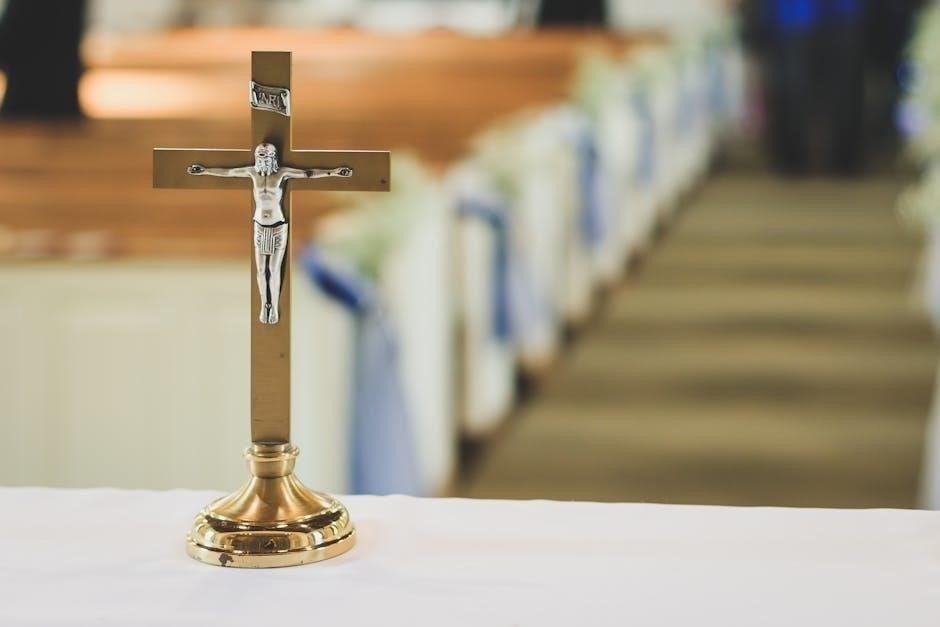
Study Questions for Chapter 2
Chapter 2 poses critical questions about leadership, fear, and rules. Key inquiries include: How does Ralph establish order? Why do the littluns fear the beast? What role does the conch play?

Comprehension Questions
- What rules does Ralph establish during the assembly, and how does he plan to enforce them?
- Describe the littluns’ fear of the “beast” and how it affects the group’s dynamics.
- What is the significance of the conch shell in maintaining order during discussions?
- How does Jack’s attitude toward hunting and leadership begin to conflict with Ralph’s priorities?
- What role does Piggy play in the group, and how does his input influence decisions?
- What event causes the boys to realize their vulnerability on the island?
- How does the concept of the “beast” reflect the boys’ deeper fears and superstitions?
- What does Ralph’s leadership style reveal about his understanding of civilization?
- How does the group’s behavior during the assembly show the beginning of power struggles?
These questions help readers understand key events, characters, and themes in Chapter 2;
Analysis Questions
The following questions encourage a deeper exploration of the themes, characters, and literary elements in Chapter 2 of Lord of the Flies.
- How does the conch shell symbolize democracy, and what happens when its power begins to wane?
- Analyze Jack’s growing obsession with hunting and its implications for the group’s survival.
- What does the fear of the “beast” reveal about the boys’ psychological state and their understanding of the island?
- Examine Ralph’s leadership style and how it contrasts with Jack’s approach to power.
- How does Piggy’s role as the voice of reason influence the group’s decisions, and why is his input often dismissed?
- Discuss the significance of the littluns’ fear and how it reflects the broader theme of savagery vs. civilization.
- What does the assembly scene reveal about the boys’ ability to maintain order and cooperate?
- How does Golding use the “beast” to explore the idea of fear as a destructive force?
These questions invite readers to critically evaluate the chapter’s themes and character dynamics.
Critical Thinking Questions
These questions challenge readers to reflect on the deeper implications of Chapter 2 and its relevance to human behavior and societal structures.

- How does the concept of fear, as seen in the boys’ belief in the “beast,” influence group dynamics and decision-making?
- What does Ralph’s reliance on the conch shell reveal about his understanding of authority and leadership?
- In what ways does Jack’s desire for power mirror real-world political or social conflicts?
- How does the breakdown of the assembly reflect the challenges of maintaining order in the absence of adult supervision?
- What does Piggy’s marginalization suggest about how societies treat intellectual or minority voices?
- How does the boys’ fear of the unknown drive their actions, and what does this say about human nature?
- What lessons can be drawn from the boys’ inability to prioritize both safety and survival effectively?
These questions encourage readers to connect the events of Chapter 2 to broader themes and real-world implications.
Answer Key for Chapter 2 Questions
Ralph’s rules include holding the conch to speak and punishing rule-breakers. Fear of the beast escalates tension. Jack’s aggression grows, while Piggy’s glasses symbolize rationality and order.
Ralph establishes rules like holding the conch to speak and punishment for violations. The fear of the beast escalates tension. Jack’s ambition becomes evident, while Piggy’s glasses symbolize rationality. The littluns fear a “snake-like figure,” reflecting growing superstition. Ralph’s leadership emphasizes order, while Jack’s aggression hints at future conflicts. The conch shell remains a symbol of democracy, but its power wanes as fear and chaos rise. These elements highlight the themes of civilization vs. savagery and leadership dynamics, showcasing the boys’ fragile grip on order and their descent into primal behavior.
Detailed Explanations of Answers
In Chapter 2 of Lord of the Flies, Ralph’s leadership is characterized by his attempt to establish rules to maintain order, such as requiring the conch shell to be held by anyone who wishes to speak. This rule, suggested by Piggy, aims to ensure democracy and fairness in discussions. Ralph enforces this rule because he believes it is essential for maintaining civility and order on the island, which is crucial for their survival and potential rescue.
Jack Merridew’s behavior becomes increasingly aggressive as he becomes obsessed with hunting pigs. His focus on hunting stems from a desire for power and recognition, which he believes hunting provides. This obsession begins to overshadow the group’s primary goal of being rescued, highlighting Jack’s growing ambition and desire for control.
The conch shell serves as a symbol of order and civility. It represents democracy, as holding it grants the right to speak while others listen. However, as the chapter progresses, the conch’s power diminishes, reflecting the group’s descent into chaos and savagery. This decline underscores the importance of adhering to rules and symbols of order to maintain civilized behavior.
The littluns’ fear of a “snake-like figure” they call the beast spreads quickly, creating tension and paranoia. This fear distracts the group from their goals of survival and rescue, weakening their unity and cooperation. The fear of the beast symbolizes the unknown dangers on the island and the boys’ vulnerability to superstition and fear.
Ralph and Jack’s power struggle becomes evident as they prioritize different goals. Ralph focuses on building shelters and maintaining a fire for rescue, while Jack is consumed by hunting. This conflict highlights their differing leadership styles: Ralph prioritizes survival and rescue, while Jack seeks immediate gratification and power.
Piggy plays a crucial role as the voice of reason, mediating between Ralph and Jack and emphasizing the importance of rules. However, his efforts are often overlooked, illustrating how intelligence and wisdom can be overshadowed by brute strength and charisma in leadership.
Overall, the detailed explanations reveal how the boys’ initial attempts at creating a civilized society begin to unravel. The fear of the beast, Jack’s rising aggression, and the diminishing power of the conch shell all contribute to the breakdown of order and the emergence of more primitive behaviors, foreshadowing the novel’s themes of savagery and the loss of innocence.
Chapter 2 of Lord of the Flies highlights the boys’ early struggles with order, fear, and leadership, setting the stage for the novel’s exploration of humanity and savagery.
Recap of Chapter 2
Chapter 2 of Lord of the Flies delves into the boys’ attempts to establish order and rules on the island. Ralph, as the elected leader, introduces the conch shell as a tool for maintaining democracy during meetings. The group discusses the importance of building shelters and keeping a fire lit for potential rescue. However, the assembly reveals growing fears, particularly among the littluns, who speak of a mysterious “beast” on the island. Jack’s obsession with hunting emerges, causing tension with Ralph over priorities. The chapter highlights the boys’ fragile sense of civilization and the beginnings of internal conflicts. Themes of leadership, fear, and the struggle between order and savagery are introduced, setting the stage for the novel’s exploration of human nature.
Reflection on the Significance of Chapter 2
Chapter 2 of Lord of the Flies is pivotal in establishing key themes and foreshadowing the novel’s trajectory. The introduction of the conch shell as a symbol of order and democracy highlights the boys’ initial attempt to mimic societal structures. However, the emergence of fear, particularly the “beast,” underscores the fragility of their civilization. The power struggle between Ralph and Jack begins to surface, reflecting the broader conflict between order and savagery. The chapter also reveals the littluns’ vulnerabilities and Piggy’s rational voice, emphasizing the loss of innocence. These elements collectively set the stage for the boys’ descent into chaos, illustrating how fear and ambition destabilize their fragile society. Chapter 2 serves as a cornerstone for understanding the novel’s exploration of human nature and the effects of isolation.